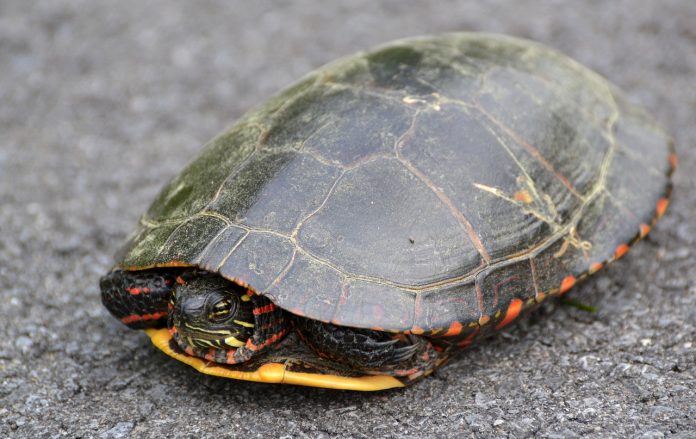It’s peak nesting season for turtles in Ohio, and as a result, it’s likely you’ll see them crossing roads more often. Because turtles are slow movers, they are at a greater risk than other animals for being hit by moving vehicles. Fortunately, awareness of the danger turtles face during nesting season has grown.
Many motorists will stop this year to get turtles out of the path of oncoming traffic. However, it doesn’t always mean those turtles have been rescued. These good samaritans can unintentionally be a danger to turtles if they don’t understand how to properly help them. Learn how to help turtles cross roadways unharmed, without doing more damage than good in the process.
Tips to help turtles cross the road safely
- Get the word out. If you’ve seen turtles cross the road in your area, get the word out. Post to your local noisy neighbors group on Facebook, and share information on how motorists can help.
- Drive slower and pay attention. In areas where turtles are crossing, lowering your speed and paying close attention to make sure the road is clear can help reduce turtle mortalities.
- Only assist a turtle in the road if it’s safe to do so. Never put yourself or other motorists in danger. Be aware of your surroundings and traffic before pulling off to the side of the road and turning your hazard lights on to help a turtle cross the road. Don’t stop in heavy traffic areas, on roadways with high-speed limits or in areas with blind spots.
- Place them on the correct side of the road and point them in the right direction. If you stop your car to physically help a turtle cross the road, make sure to point it in the same direction it was moving when you found it on the side of the road where it was heading. Placing it on the side of the road it came from or facing the turtle towards the road on the side where it was headed may encourage it to venture back out into traffic to attempt to cross again.
- Don’t handle the turtle more than necessary. Handling turtles more than necessary to get them safely across the road can disrupt their normal behavior. Only pick up the turtle for as long as is needed to get it to safety.
- Handle turtles gently. When you pick a turtle up, you should grasp it gently along its shell near the edge or midpoint of its body. Additionally, be aware that turtles usually empty their bladder when they are lifted off the ground. Be careful not to drop a turtle if it begins to pee.
- Avoid picking up snappers and softshells. Snapping turtles and softshell turtles are aggressive, quick and possess a powerful bite if provoked in the slightest. If you encounter these turtles, let them be.
- Allow unassisted turtle crossings. You should always allow the aggressive species listed above cross on their own, but you should also let other species cross on their own when they can do so safely. Just avoid rapid movements and watch from a distance, so the turtle isn’t startled. If it is disturbed during its crossing, it may retreat into its shell, stop in the middle of the road or change direction.
- Never relocate a turtle. Although you may think you know of a more suitable location for the turtle you saved, turtles have home territories and have a better chance of survival and reproduction if they are left where they are found.
- Don’t keep wild turtles as pets. Wild turtles easily become stressed and do poorly in captivity. In captivity, they are at an increased risk of being exposed to diseases. Furthermore, when kept as a pet, turtles don’t have the opportunity to reproduce, which can affect wild turtle populations in a big way.
- Report an injured turtled. If you find an injured turtle, put it in a box, carefully record the details of the rescue location, so that the turtle can be returned once it has healed, and contact your local Division of Wildlife District office. Find your local district office here.













Excellent article. We moved to northwest AR several years ago and there are lots of turtle crossings. Appreciate knowing how to help move them safely and in their best interest.